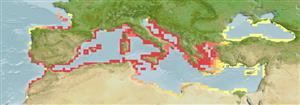>
Blenniiformes (Blennies) >
Blenniidae (Combtooth blennies) > Salariinae
Etymology: Aidablennius: The name could have been after Aida, the title of Verdi's opera which takes place in Egypt (country of the sphinx) (C. Belfiore, pers. comm. 06/18).
More on author: Valenciennes.
Environment: milieu / climate zone / depth range / distribution range
экология
морской демерсальный. Subtropical; 47°N - 20°N, 18°W - 42°E
Eastern Atlantic: Morocco. Also known from the Mediterranean and Black Sea.
Size / Вес / Возраст
Maturity: Lm ? range ? - ? cm
Max length : 8.0 cm TL самец/пол неопределен; (Ref. 5981)
Found in very shallow, rocky, littoral zone, exposed to sunlight and surf; on horizontal, algae-covered terraces. Feed on benthic invertebrates and algae (Ref. 5981). Oviparous. Eggs are demersal and adhesive (Ref. 205), and are attached to the substrate via a filamentous, adhesive pad or pedestal (Ref. 94114). Males guard eggs in burrows (Ref. 5981). Larvae are planktonic, often found in shallow, coastal waters (Ref. 94114).
Life cycle and mating behavior
половая зрелость | размножение | нерест | икра | Fecundity | личинки
Oviparous, distinct pairing (Ref. 205). Males guard eggs in burrows (Ref. 5981).
Zander, C.D., 1986. Blenniidae. p. 1096-1112. In P.J.P. Whitehead, M.-L. Bauchot, J.-C. Hureau, J. Nielsen and E. Tortonese (eds.) Fishes of the North-eastern Atlantic and the Mediterranean, volume 3. UNESCO, Paris. (Ref. 5981)
Статус Красного Списка МСОП (Ref. 130435: Version 2024-2)
Угроза для людей
Harmless
Использование человеком
дополнительная информация
инструменты
Специальные отчеты
Скачать в формате XML
ресурсы в Интернет
Estimates based on models
Preferred temperature (Ref.
123201): 17 - 19.9, mean 18.8 °C (based on 359 cells).
Phylogenetic diversity index (Ref.
82804): PD
50 = 1.0000 [Uniqueness, from 0.5 = low to 2.0 = high].
Bayesian length-weight: a=0.00776 (0.00356 - 0.01695), b=3.00 (2.81 - 3.19), in cm total length, based on LWR estimates for this (Sub)family-body shape (Ref.
93245).
Trophic level (Ref.
69278): 2.8 ±0.0 se; based on diet studies.
устойчивость к внешним воздействиям (Ref.
120179): высокий, минимальное время удвоения популяции до 15 месяцев (Preliminary K or Fecundity.).
Fishing Vulnerability (Ref.
59153): Low vulnerability (10 of 100).
